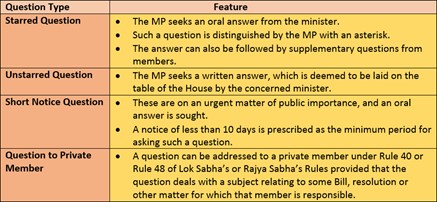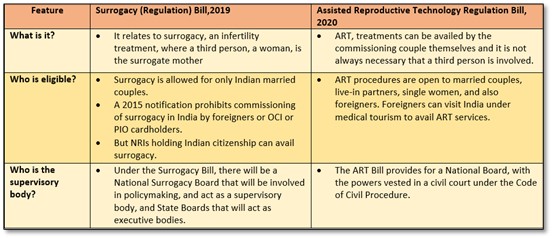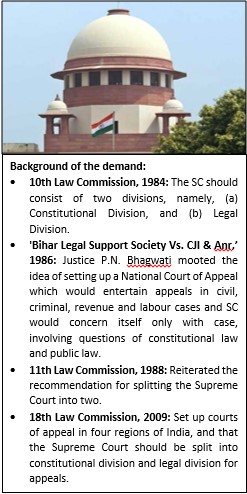Wednesday, 24th November 2021
SDG Urban Index and Dashboard 2021–22
In News
NITI Aayog under the Indo-German Cooperation released inaugural SDG Urban Index and Dashboard 2021–22.
Relevant Details
- The SDG Urban Index and Dashboard ranks 56 urban areas across 15 SDGs on 77 indicators and 46 targets.
- SDG 14 (life below water) has not been included as it is relevant for only coastal areas, and SDG 17 (partnerships for the goals) has been excluded as it is not relevant at the ULB level.
- In total, there are 17 Sustainable Development Goals and the associated 169 targets and 232 indicators.
- Out of 56 urban areas ranked in the index, 44 have a population of above one million, and 12 are state capitals with a population of less than a million.
- It highlights the strengths and gaps of ULB-level data, monitoring, and reporting systems.
- This transformative change is quite essential, given the increasing prominence of our cities and urban areas in charting the future of development in India.
Important Findings
- For each SDG, the urban areas are ranked on a scale of 0-100. A score of 100 implies that the urban area has achieved the targets set for 2030; a score of 0 implies that it is the farthest from achieving the targets among the selected urban areas.
- The statistical methodology for the SDG Urban Index was used for the SDG India Index and North Eastern Region District SDG Index as well.
- Urban areas have been classified as below based on their composite score:
- Aspirant: 0–49
- Performer: 50–64
- Front-Runner: 65–99
- Achiever: 100
- Overall findings -

Sources:
India Energy Exchange
In News
India Energy Exchange (IEX) has resumed trading of renewable energy certificates (RECs) after a gap of almost 16 months.
About India Energy Exchange
India presently has two power exchanges:
- India Energy Exchange (IEX): India’s premier energy marketplace that provides a nationwide automated trading platform for the physical delivery of electricity, renewables, and certificates and
- PXIL: India’s first institutionally promoted Power Exchange that provides innovative and credible solutions to transform the Indian Power Markets.
- Both have resumed trading of renewable energy certificates or green certificate that were suspended in July 2020.
What is a Power Exchange?
- A power exchange functions on the lines of commodity exchanges and provides a platform for buyers and sellers of electricity to enter into spot contracts for the same day, coming day, and on a weekly basis up to 11 days.
- Of about 1,381 billion units (BU) of electricity consumed in India, only 7% is traded on power exchanges.
Renewable Energy Certificates (RECs)
- RECs are a market-based instrument that certifies the bearer who owns one megawatt-hour (MWh) of electricity generated from a renewable energy resource.
- Once the power provider has fed the energy into the grid, the REC received can then be sold on the open market as an energy commodity.
- RECs earned may be sold to other entities as carbon credits to offset their carbon emissions.
- They are also known as Green Tags, Tradable Renewable Certificates (TRCs), Renewable Electricity Certificates, or Renewable Energy Credits.

Source:
- India Energy Exchange resumes trading of renewable energy certificates
- Green certificates trade to resume on IEX, PXIL from Wednesday
- Green certificates trade to resume on IEX, PXIL from Wednesday after 16 months
- Renewable Energy Certificate (REC)
Image Source:
Strategic Oil reserves
In News
India plans to release about 5 million barrels of crude oil from its strategic oil reserve.
About the News
- India will carry out this task in coordination with other major consumers, including the US, China, Japan and South Korea.
- Reasons for this task:
- India’s concerns over inflation due to high prices of oil.
- To lower global energy prices by releasing crude stockpiles.
- OPEC’s rejection to requests for increasing oil production to cool down prices.
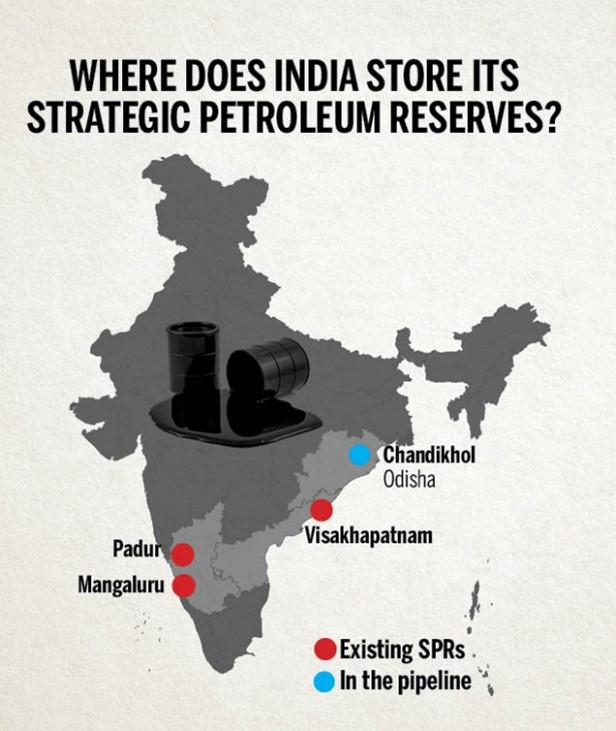
What are Strategic oil reserves?
- The Strategic Petroleum Reserve is the emergency oil stockpile which can be used in emergency circumstances after government approval.
- In addition, Oil Marketing Companies (OMCs) in the country have storage facilities for crude oil and petroleum products for 64.5 days, thus the current total national capacity for storage of crude oil and petroleum products currently is 74 days.
- Purpose of establishing Strategic oil reserve:
- High oil imports: India is dependent on imports to meet 85% of oil demand and is the third largest importer of crude oil in the world.
- Oil Security: The strategic petroleum reserves in India were set up to ensure that there is oil security in case of global scarcity like it happened during Gulf War in 1990.
- Who manages it: The Indian Strategic Petroleum Reserves Limited manages the reserves. It is a subsidiary of the Oil Industry Development Board, which falls under the Ministry of Petroleum and Natural Gas.
- Location: The locations are in the coastal areas of India and are at points from which they can easily be taken to refineries. These are sufficient to meet around nine-and-a-half days of India’s crude oil requirements. The Locations are:
- Visakhapatnam (Andhra Pradesh, 1.33 million Tonnes)
- Mangaluru (Karnataka, 1.5 million Tonnes)
- Padur (Karnataka, 2.5 million Tonnes)
- 2 new under consideration: With a total storage capacity of 6.5 MMT underground storage at Chandikhol (4 MMT) and Padur (2.5 MMT) in July 2021, on PPP Mode.

Source:
Dutch discovery of Tasmania
On November 24, 1642, Dutch navigator Abel Janszoon Tasman, who sailed from Jakarta to investigate the practicality of a sea passage eastward to Chile and to explore New Guinea, skirted the southern shores of Tasmania. Tasmania is essentially a mountainous island. Tasmania, formerly Van Diemen’s Land, island state of Australia. The island of Tasmania contains some of the most spectacular mountain, lake, and coastal scenery in the country, and much of its land is protected in national parks and reserves. The state also produces a major portion of Australia’s hydroelectric power and possesses a great diversity of natural resources.

Source:
25 Years of PESA Act: Status of Implementation and the way forward
In News
The Panchayats (Extension to the Scheduled Areas) Act, 1996 (PESA) has completed 25 years.
Introduction
- The PESA was enacted to extend the provisions of 73rd Constitutional Amendment (the Part IX of constitution which deals with Panchayats) to the Scheduled Areas under 5th
- Based on the recommendation of Dilip Singh Bhuria committee in 1995, the government of India brought in PESA in 1996.
- The PESA Act provides the constitutional framework to preserve tribal self-governance, culture, customary laws and to protect their traditional way of living in Schedule V areas.
- The Provisions of the PESA is an important and key legislation to empower the tribal communities. The PESA Act is called “Constitution within the Constitution”. The act aims at devolving governance to Panchayats/Gram Sabhas in Schedule V areas for mainstreaming tribal development.
- The Act came into force on 24th December, 1996 and is currently applicable in 10 states: Andhra Pradesh, Chhattisgarh, Gujarat, Himachal Pradesh, Jharkhand, Madhya Pradesh, Maharashtra, Odisha, Rajasthan and Telangana.
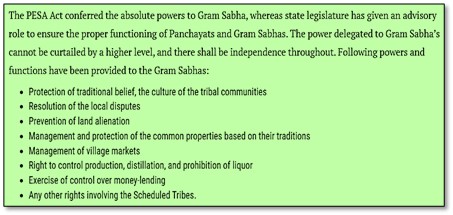
Significance of PESA
- Participatory Democracy: The fundamental spirit of PESA Act is that rather than delegation, it devolves power and authority directly to Gram Sabha and Panchayats.
- Respect for sovereignty of Tribal Culture: This act calls for all legislation w.r.t Schedule V areas to be in conformity with the customary law, social and religious practices and traditional management practices of the community resources.
- Empowers Gram Sabha: The PESA Act aims to bring the tribal people into the mainstream society through enablement of their self-governance. This has been aimed by giving special powers to the Gram Sabha.
- The Act protects tribal people from money lenders, land alienation and provides them ownership on Minor Forest Produce (MFP), minor water bodies and community assets.
- Formal Recognition of Tribal Laws: PESA is unique as it brings together the simple system of tribal communities governed by their respective customs and traditions, and the formal system of the State.
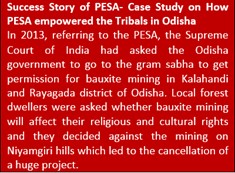
Key Provisions and Present Status of PESA Implementation
All the ten States having Fifth Schedule Areas are required to make their State Panchayati Raj Acts and concerned subject laws compliant with the provisions of PESA Act, 1996. Here is the current status of their implementation -
- Notification of PESA Rules
- Despite 25 years after its enactment, the rules of the PESA are yet to be notified in four tribal populated States--Madhya Pradesh, Chhattisgarh, Odisha and Jharkhand, thus depriving the adivasis from their right to empowerment.
- The draft model PESA rules had been circulated by the Union Ministry of Panchayati Raj (MoPR) in 2009 to the 10 PESA states.
- Non-uniformity in implementation of Provisions: While the constitution of gram sabhas was made mandatory in states, the powers and functions of the gram sabhas have been left to the discretion of the state legislatures. As a result, different states have developed powers and functions for this body differently.
- Example: The Power to enforce Prohibition has been given to the Gram Sabha in Himachal Pradesh and Gujarat has given the same power to the intermediate tier of the Panchayati Raj system and not to the Gram Sabha
Is PESA still relevant?
- The relevance of PESA stems from the very fact that even today the Schedule V areas continue to face those challenges which led to its enactment.
- Relevance of PESA becomes even more important in view of India’s commitment to sustainable development to achieve SDG goals.
- It is also relevant given the constitutional mandate of a welfare state respecting the rights of tribals while ensuring their holistic development.
- PESA laws of maintenance of autonomy and tribal culture remained obscure: The incidences like the criminalisation of the Pathalgadi movement, wherein Adivasis erected stone slabs to demarcate the area of their villages’ jurisdiction mark an attempt to make PESA irrelevant..
- Parallel Laws: Various other laws included many provisions of PESA. For instance, the Land Acquisition Act, 2013 empowered gram sabhas immensely. Similarly, the Forest Right Act, 2006 has provisions of PESA and now when people need to protect their rights and resources; they look up to these laws.
Challenges in Implementation of PESA
- Lack of awareness about PESA amongst the tribal community: Although PESA had come into existence in 1996, it is observed that the local tribal community of Fifth Schedule areas has very limited understanding of the law and powers extended to them under PESA.
- Limited autonomy of Gram Sabha and panchayats at the lower level: In many cases, it is observed that the Gram Sabhas are influenced by nontribal individuals.
- Overseeing the implementation of the Act by the functionaries who may not have proper understanding of tribal culture. There exists a knowledge gap in understanding the tribal culture and their way of living by some of the functionaries.
- Lack of institutional mechanisms and enabling ecosystem – such as adequate capacity, proper access to information etc., – for empowering Gram Sabhas as centres of self-governance
- Presence of committees and forums operating parallel to the PESA Gram Sabhas: The Gram Sabhas to be conducted under PESA, often see low turnout and participation, due to presence of parallel customary forums and other committees. The efforts towards creation of awareness and publicity for the meetings of Gram Sabha also need to be improved.
- Additionally, the non-compliance or violation of provisions under PESA, Administrative apathy, Gap in adoption of PESA in letter and spirit etc. hamper the implementation.
- Example: In Korba district of Chhattisgarh, local community have been protesting government decision of acquiring land using Coal Bearing Act of 1957 – something that experts argue is illegal and against the spirit of PESA.
Interventions by Ministry of Panchayati Raj (MoPR)
- MoPR had formulated Draft Model Rules for PESA which were circulated among the PESA States in 2009.
- Under Rashtriya Gram Swaraj Abhiyan (RGSA), PESA States are being assisted financially.
- MoPR had organized One-Day State-level workshops in the PESA States during 2014-15 to give a fillip to the implementation of PESA and improve the level of awareness on the subject among the representatives of Panchayats.
- The ‘Handbook of Community Mobilisation in Fifth Scheduled Areas’ was released in 2015. The book contains basic information about the provisions of PESA, principles and methods of community mobilization and role of Gram Sabha/Community Mobilisers and PESA Coordinators.
- A separate guidelines document for participatory Gram Panchayat Development Plan (GPDP) for local development in PESA Areas was circulated to PESA States. In addition, an advisory on bonded labour and distress migration in PESA areas was also issued.
Conclusion: Issues of non-conformity between the Central PESA Act and State PESA Act/ Rules need to be resolved in a time bound manner. To aid in effective functioning of Gram Sabhas as envisaged in the PESA Act, there may be need for formal notification of PESA villages by the State. State Panchayati Raj Departments may consider establishment of a separate PESA section to facilitate for the special requirements of PESA Gram Sabhas. All these steps would lead to real fulfillment of what PESA has envisaged.
Question: The fundamental spirit of PESA Act for areas under Schedule V is to devolve power and authority directly to Gram Sabha and Panchayats. In this context, examine the challenges in fulfilment of this spirit of PESA.
Sources:
- One-day Conference on PESA organised on completion of 25 years of the Act
- Concept Note on The Provisions of the Panchayats (Extension to the Scheduled Areas) Act, 1996(PESA)
- PESA: The wait for reforms on the ground continues even after 25 years
- 25 Years of PESA: Violations and Attempts at Dilution
- 25 years on, many Indian states haven’t implemented a law that empowers Adivasi communities
- Rules of 25-yr-old PESA still not implemented in 4 States
- Centre asks laggard states to expedite notification of PESA
- Explained: What is PESA Act, and politics behind its implementation in Chhattisgarh
- Panchayat Raj (Extension to Scheduled Areas) Act, 1996: The Travails of a Governance Law
- Yojana Article
- Telangana: Empowered by PESA, village committees enforce prohibition in tribal areas
- PANCHAYAT (EXTENSION TO THE SCHEDULED AREAS) PESA AND LWE :CHHATTISGARH, JHARKHAND, AND ODISHA
- PESA laws of maintenance of autonomy and tribal culture remained obscure
- PESA committees to empower tribals
- What Lies Behind the Failure of PESA: India’s Greatest Initiative to Empower Tribal Communities
Mammatus Clouds
This is image of an unusual cloud formation in Argentina, which looked like giant cotton balls. The cloud formation phenomenon which is known as Mammatus clouds. Mammatus basically refers to distinctive cloud formations that are separated by a bulge or protrusion emerging from the base of another cloud. Formations in Mammatus clouds usually happen at the base of large cumulonimbus clouds and are associated with thunderstorms. The presence of such clouds often indicates the arrival of heavy rain, lightning and even hailstorms.

Source:
Spacecraft kamikaze
- Context: NASA has decided to fly spacecraft kamikaze into an asteroid to prevent its collision with Earth.
- This is an unmanned craft launched under the mission called DART (Double Asteroid Redirection Test).
- DART is a planetary defense-driven test of technologies for preventing an impact of Earth by a hazardous asteroid. DART will be the first demonstration of the kinetic impactor technique to change the motion of an asteroid in space.
- After it is launched, it will head for a pair of asteroids that circle around each other, Dimorphos and Didymos that are about 10 million km away.
- DART will reach there in about 10 months and will also deploy a small satellite carrying cameras.
- Flying at about 25,000 km/h, DART will crash head-on into Dimorphos (150m in diameter) not to destroy it but to deflect the asteroid from its path preventing a disastrous collision.
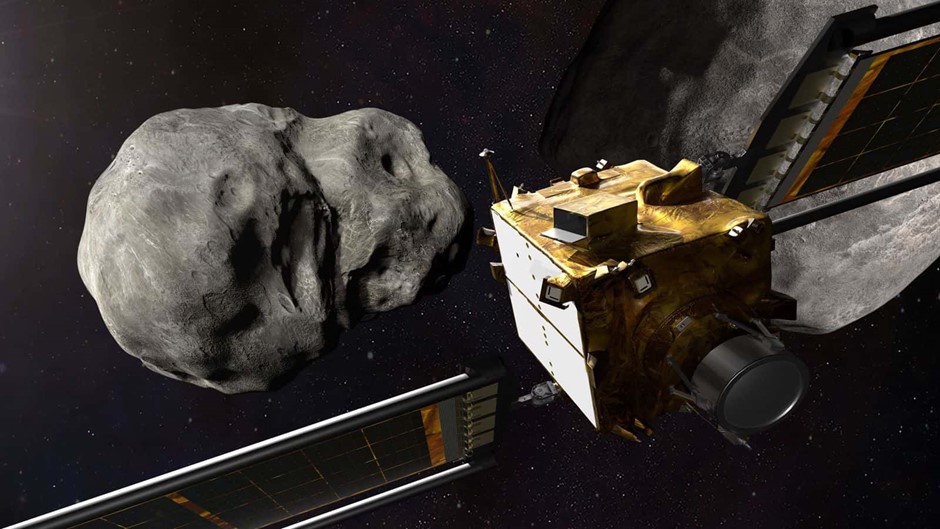
Source:
Rezang La memorial
- Context: Rezang La memorial has been inaugurated recently on the 59th anniversary of the battle of Rezang La.
- The memorial was constructed in 1963 in the Chushul plains, at an altitude of over 15,000 feet and is very close to the India-China border.
- It honours the troops from the 13 Kumaon Regiment, who had defended Rezang La and the surrounding areas located at over 16,500 feet on the Kailash Ranges during the 1962 War from the Chinese People’s Liberation Army.
- Rezang La is a mountain pass on the Line of Actual Control in Ladakh located between village of Chushul and the Spanggur Lakethat stretches across both Indian and Chinese territories.
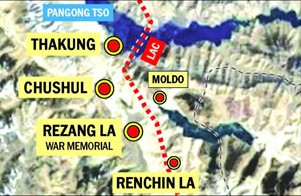
Source:
- Rezang La monument symbolises India’s tough stand: Rajnath Singh
- On Rezang La battle anniversary, Rajnath inaugurates renovated memorial near China border
- Recalling the heroes of Rezang La
Image Source:
Magnitsky legislation
- Context: A British national has requested the UK government to apply the “Magnitsky” sanctions regime against those involved in the “abduction” of Princess Latifa of the United Arab Emirates (UAE).
- Magnitsky legislation refers to laws providing for governmental sanctions against foreign individuals who have committed human rights abuses or been involved in significant corruption.
- It is the first global thematic sanctions regime that focuses on human rights
- They originated with the United States which passed the first Magnitsky legislation in 2012.
- The name is derived from Sergei Magnitsky, a Russian tax lawyer who uncovered a $230-million fraud committed by tax officials in 2007, and was jailed on charges of tax evasion in 2008.

Source:
- Michel threatens to go on hunger strike in letter to Boris Johnson
- Can the Magnitsky Act become an effective tool to punish human rights abusers and lead to change among governments and corporations that do business with them?
Image Source:
Shakti: Advanced Electronic Warfare Suite
- Context: The Advanced Electronic Warfare (EW) Suite ‘Shakti’ was recently handed over to the Indian Navy.
- The Shakti EW system will provide an electronic layer of defence against modern radars and anti-ship missiles to ensure electronic dominance and survivability in the maritime battlefield.
- This system will replace the earlier generation EW Systems of the Indian Navy.
- It has been integrated with the wideband Electronic Support Measures (ESM) and Electronic Counter Measure (ECM) for the defence of Indian Navy Ships against missile attacks.
- It will help in finding accurate direction and interception of modern radars and has a built-in radar fingerprinting and data recording replay feature for post-mission analysis.
- It has been designed and developed by Defence Electronics Research Laboratory Research and Development Organisation DRDO.
- First Shakti system has been installed on-board INS Visakhapatnam and is being installed on-board Indigenous Aircraft Carrier, INS Vikrant.

Source:
Image Source:
The need for palliative care in India has never been greater: IE
Essence: The article sheds light on the sorry state of palliative care in India. With the rise in non-communicable diseases like Cancer, ‘Palliative Care’ has become extremely essential. It is defined by WHO as the active total care of patients whose disease is not responsive to curative treatment. It is related to people suffering from serious health issues. It is almost non-existent at the grassroots in India. It requires trained personnel, interdisciplinary team of healthcare professional among other things.
The article provides some suggestions like to move from a death-denying society to one that accepts death to give hope to patients and their families. There is also a need for the treating specialist to continue to be involved. There is need for palliative Care become important in order to achieve the aim of best quality of life of patients and their families.
Why to read this article?
- To understand what is Palliative Care and why there is need of Palliative Care has never been greater.
- To understand the grassroot realities of Palliative care in India.
- To realize the importance of Palliative health services as it is one of the components of Universal Health Care and relevant for the syllabus of GS II (Social Justice: Issues related to Health)
Source:
The duality in India’s economic recovery: HBL
Essence: The article highlights the duality that India is facing in its economic recovery. The duality exists due to the disparity in vaccine coverage between low income and high-income state. The higher income States, which are powerhouse of economic activity, have vaccinated 45-50 per cent of its eligible population. The ratio is less than 30 per cent in poorer. The duality is also more pronounced between the incomes of the populace.
Though the economy is on the growth trajectory, most of it is due to spending done by the vaccinated and higher income people, who have regained confidence and resumed spending. Whereas the rest in the bottom 50 per cent is suffering from permanent loss of jobs and incomes further widening the gap. Sooner or later, the unvaccinated workers from poorer States will migrate to richer States, leading to the resurgence of cases. To address this vaccination rates should be increased in low-income states along with a fiscal policy that could spur the demand in the low-income states also.
Why you should read this article?
- To understand the reasons for duality in India’s economic recovery.
- To understand the steps India should take to address this issue.
Source:
Lessons from past sanitation policies for future efforts: LM
Essence: The article throws light on the fact that despite many efforts being taken, India is far from achieving The United Nations’ Sustainable Development Goal (SDG) No. 6. The SDG 6 aims to “ensure availability and sustainable management of water and sanitation for all" by 2030. The goal if achieved will help in accomplishing other SDG goal such as SGD 1 (poverty eradication), SDG 2 (improving nutrition), SDG 3 (promotion of well-being).
To solve the problem India should focus more on Behavioral change as just providing the infrastructure would not suffice. There is need to bring attitude change towards the sanitation. For this collaboration with NGO’s will help accelerate the spread of use of toilets. Along with the women should be used as a harbinger of change as they are the one who bear a disproportionate burden of Open defecation.
Why you should read this article?
- To understand the initiatives taken by the government so far in the field of sanitation.
- To understand the reasons that is inhibiting India from realizing the SDG 6.
- To understand the steps that India should take to realize this goal.
- The article provides a fantastic example to quote in the mains answer in GS 2- (social justice).
Sources:
A profession for a cause
Background
- A profession that has been utilized for the betterment of a society is more like a service than a means to earn a living.
- Similarly, Mohammad Saif Khan of the Malihabad town of UP has used his skill of boxing to empower girls in his town.

Boxing for a cause
- Saif was a professional boxer and participated at the State and National level. But, he ended his career soon, having realized his lack of capacity to compete on international stage.
- But one incident of rape in his neighborhood changed the picture altogether.
- He noticed how the society is still holding the burden of family name and pride on the price of the rights of the raped victim.
- He was shaken to the core and decided to start up his boxing academy for the girls so as to provide them self-defense along with a livelihood.
- He convinced the parents of the girls by providing free food during training and explaining the importance of sport quota in government jobs.
- Till date, 15 girls from the academy have made it to the national boxing camp and have won gold medals at district and state level.
Quote:
Life engenders life. Energy creates energy. It is by spending oneself that one becomes rich.
Sarah Bernhardt
Source:
Share the article
Get Latest Updates on Offers, Event dates, and free Mentorship sessions.

Get in touch with our Expert Academic Counsellors 👋
FAQs
UPSC Daily Current Affairs focuses on learning current events on a daily basis. An aspirant needs to study regular and updated information about current events, news, and relevant topics that are important for UPSC aspirants. It covers national and international affairs, government policies, socio-economic issues, science and technology advancements, and more.
UPSC Daily Current Affairs provides aspirants with a concise and comprehensive overview of the latest happenings and developments across various fields. It helps aspirants stay updated with current affairs and provides them with valuable insights and analysis, which are essential for answering questions in the UPSC examinations. It enhances their knowledge, analytical skills, and ability to connect current affairs with the UPSC syllabus.
UPSC Daily Current Affairs covers a wide range of topics, including politics, economics, science and technology, environment, social issues, governance, international relations, and more. It offers news summaries, in-depth analyses, editorials, opinion pieces, and relevant study materials. It also provides practice questions and quizzes to help aspirants test their understanding of current affairs.
Edukemy's UPSC Daily Current Affairs can be accessed through:
- UPSC Daily Current Affairs can be accessed through Current Affairs tab at the top of the Main Page of Edukemy.
- Edukemy Mobile app: The Daily Current Affairs can also be access through Edukemy Mobile App.
- Social media: Follow Edukemy’s official social media accounts or pages that provide UPSC Daily Current Affairs updates, including Facebook, Twitter, or Telegram channels.

